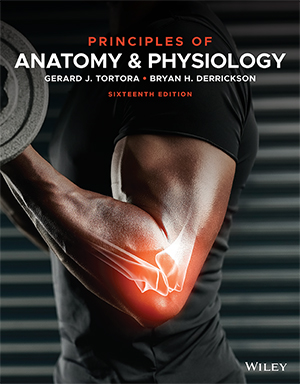
Principles of Anatomy and Physiology, 16th Edition
By Gerard J. Tortora, Bryan Derrickson
From the very first edition, Principles of Anatomy and Physiology has been recognized for its pioneering homeostatic approach to learning structure and function of the human body. The 16th edition continues to set the discipline standard by combining exceptional content and outstanding visuals for a rich and comprehensive experience. Highly regarded authors, Jerry Tortora and Bryan Derrickson motivate and support learners at every level, from novice to expert, and equip them with the skills they need to succeed in this class and beyond.
Designed for the two-semester A&P course, this program combines exceptional content and visuals for a rich and comprehensive classroom experience that is now available in WileyPLUS. When course materials are presented in an organized way, students are more likely to stay focused, develop mastery, and participate in class. WileyPLUS gives students a clear path through the course material and provides them with 3D imaging software and animations to view true-to-life anatomical structures of the body. Enhanced for a digital delivery, WileyPLUS helps students learn and explore A&P both inside and outside of the classroom.
Schedule a Demo Request Instructor AccountWant to learn more about WileyPLUS? Click Here
Promote active learning and put students in the driver’s seat with 3D interactives.
Assignable with paired assessment questions and fully accessible with interactive keyboard short cuts, 3D Interactives provide an immersive and visually stunning experience that addresses multiple learning modalities. Students can manipulate structures, interact with images, and listen to narrated explanations of physiological concepts to dive deeper into complex physiologic processes.
Replicate a true-to-life cadaver experience with world-class dissection software
Real Anatomy 2.0 is a 3-D imaging software that allows students to dissect through over 40 layers of a real human body to study the anatomical structures of all body systems. Using Real Anatomy, students can interact and practice with a real cadaver as much as they need. Additional dissection videos are also included—in this resource are cat, pig, rat, and human dissection videos. Both the cat and the pig videos include have manuals that are available within the resource for download as PDF.
Help students develop a growth mindset and picture their future career path
Practitioner’s Perspective videos share the perspective of the clinician on a clinical case study. The clinicians represent an array of possible future careers for the students, including doctors and nurses but also EMT, audiologist, acupuncturist, and radiologic technician. The practitioners are diverse and represent broad student populations. Each practitioner shares an engaging real-life story about a person who is experiencing a disease state such as kidney stones, multiple sclerosis, burns, or a cochlear implant.
Flip your classroom or recreate the benefits in-person lecture
Created by author Mark Nielsen, Concept Lectures provide a great resource for professors who want to incorporate more of a flipped classroom into their teaching. These video lectures are dynamic and help students focus on key concepts and make connections to anatomy.
Bring physiology to life with 3D animations
3-D Physiology uses state-of-the-art 3D visualization to bring the 15 most complicated topics for students to learn and teachers to teach to life. The most requested topic, The Countercurrent Mechanism, helps students visualize a dense, very complex physiological process. Each animation is fully accessible and includes transcript and speed controls that allow students to absorb the material on their own terms.
What’s New:
-
- Adaptive Assignments Powered by Knewton ignite students’ confidence to persist so that they can succeed in their courses and beyond. By continuously adapting to each student’s needs and providing achievable goals with just-in-time instruction, Adaptive Assignments close knowledge gaps to accelerate learning.
- 3D Interactives: Assignable with paired assessment questions and fully accessible with interactive keyboard short cuts, 3D Interactives provide an immersive and visually stunning experience that addresses multiple learning modalities. Students can manipulate structures, interact with images, and listen to narrated explanations of physiological concepts to dive deeper into complex physiologic processes.
- Practitioner’s Perspective Videos: These engaging videos share the perspective of the clinician on a clinical case study. The clinicians represent an array of possible future careers for the students, including doctors and nurses but also EMT, audiologist, acupuncturist, and radiologic technician. The practitioners are diverse and represent broad student populations. Each of these practitioner’s share an engaging story about a person who is experiencing a disease state such as kidney stones, multiple sclerosis, burns, or a cochlear implant.
Course Content Updates:
-
- Refined Signature homeostatic feedback cycle illustrations: Many have been updated and several have been added to Chapter 18.
- Revised, Added, and Illustrated Clinical Connections: Includes a Clinical Connection in Chapter 23 dealing with tracheostomy, endotracheal intubations, and ventilators.
- Defined Disorders: Homeostatic Imbalances: These sections are found at the end of most chapters and include concise discussions of diseases and disorders that emphasize departures from homeostasis. They provide many answers to questions that students have about medical conditions.
- Completely Redesigned Focus on Homeostasis. Full-page summaries following each chapter or a group of chapters for each body system help students understand how each body system contributes to homeostasis by itself and through its interactions with other body systems.
- New Opening Questions: Each chapter starts with questions designed to stimulate interest and class discussion, accompanied by new illustrations.
- Updated Terminology: Virtually all eponyms have been replaced with current terminology.
Additional Features Include:
-
- Interactive VitalSource e-Text: Students can easily search content, highlight and take notes, access instructor’s notes and highlights, and read offline to any device.
Instructor Resources:
- Lecture Slides: PowerPoint presentations cover key concepts allowing the instructor to illustrate important topics with images, figures, and problems presented throughout the course.
- Test Bank is available in TestGen and as editable Word files.
- Image Gallery: Images implemented in the course are available in JPG and PPT.
- Real Anatomy Worksheets and Answer Keys: Anatomy questions using imagery from Real Anatomy.
- Clicker Questions in PowerPoint Slides: Create an active learning experience for students with interactive questions to poll students or play team-based games.
- Instructor’s Manual: Offers helpful teaching ideas, advice on course development, sample assignments, learning objectives, lecture outlines, class exercises, lecture notes, course section reviews, and more.

GERARD J. TORTORA is Professor of Biology and former Biology Coordinator at Bergen Community College in Paramus, New Jersey, where he teaches human anatomy and physiology as well as microbiology. He received his Bachelor’s Degree in Biology from Fairleigh Dickinson University and his Master’s Degree in Science Education from Montclair State College. He is a member of many professional organizations including the Human Anatomy and Physiology Society (HAPS), the American Society of Microbiology (ASM), the American Association for the Advancement of Science (AAAS), the National Education Association (NEA), and the Metropolitan Association of College and University Biologists (MACUB).
Above all, Professor Tortora is devoted to his students and their aspirations. In recognition of this commitment, he was the recipient of MACUB’s 1992 President’s Memorial Award. In 1996 he received a National Institute for Staff and Organizational Development (NISOD) excellence award from the University of Texas and was selected to represent Bergen Community College in a campaign to increase awareness of the contributions of community colleges to higher education. Professor Tortora is the author of several best-selling science textbooks and laboratory manuals, a calling that often requires an additional 40 hours per week beyond his teaching responsibilities. Nevertheless, he still makes time for four or five weekly aerobic workouts that include biking and running. He also enjoys attending college basketball and professional hockey games and performances at the Metropolitan Opera House.

Bryan Derrickson is Professor of Biology at Valencia College in Orlando, Florida, where he teaches human anatomy and physiology as well as general biology and human sexuality. He received his bachelor’s degree in biology from Morehouse College and his Ph.D. in cell biology from Duke University. Bryan’s study at Duke was in the Physiology Division within the Department of Cell Biology, so while his degree is in cell biology, his training focused on physiology. At Valencia, he has served as a member of the Faculty Senate, which is the governing body of the college, and as a member of the Faculty Academy Committee (now called the Teaching and Learning Academy), which sets the standards for the acquisition of tenure by faculty members. Nationally, he is a member of the Human Anatomy and Physiology Society (HAPS) and the National Association of Biology Teachers (NABT). Bryan has always wanted to teach. Inspired by several biology professors while in college, he decided to pursue physiology with an intent to teach at the college level. He is completely dedicated to the success of his students. He particularly enjoys the challenges of his diverse student population, in terms of their age, ethnicity, and academic ability, and finds being able to reach all of them a rewarding experience. His students continually recognize Bryan’s efforts and care by nominating him for a campus award known as the “Valencia Professor Who Makes Valencia a Better Place to Start.” Bryan has received this award three times.
- Chapter 1: An Introduction to the Human Body Chapter 2: The Chemical Level of Organization Chapter 3: The Cellular Level of Organization Chapter 4: The Tissue Level of Organization Chapter 5: The Integumentary System Chapter 6: The Skeletal System: Bone Tissue Chapter 7: The Skeletal System: The Axial Skeleton Chapter 8: The Skeletal System: The Appendicular Skeleton Chapter 9: Joints Chapter 10: Muscular Tissue Chapter 11: The Muscular System Chapter 12: Nervous Tissue Chapter 13: The Spinal Cord and Spinal Nerves Chapter 14: The Brain and Cranial Nerves Chapter 15: The Autonomic Nervous System Chapter 16: Sensory, Motor and Integrative Systems Chapter 17: The Special Senses Chapter 18: The Endocrine System Chapter 19: The Cardiovascular System: The Blood Chapter 20: The Cardiovascular System: The Heart Chapter 21: The Cardiovascular System: Blood Vessels and Hemodynamics Chapter 22: The Lymphatic System, Nonspecific Resistance to Disease, and Immunity Chapter 23: The Respiratory System Chapter 24: The Digestive System Chapter 25: Metabobrsm Chapter 26: The Urinary System Chapter 27: Fluid, Electrolyte, and Acid-Base Homeostasis Chapter 28: The Reproductive Systems Chapter 29: Development and Inheritance Appendix A Measurements Appendix B Periodic Table Appendix C Normal Values for Selected Blood Tests Appendix D Normal Values for Selected Urine Tests Appendix E Answers to Critical Thinking Questions Appendix F Medical Eponyms

